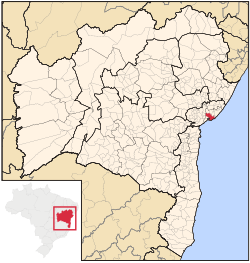
Back Salvador ACE Salvador da Bahia AF ሳውቫዶር ዳ ባዒየ AM سلفادور (باهيا) Arabic Salvador (Brasil) AST Salvador (Bahia) AY Salvador, Baiya AZ Salvador, Bahia BAN Салвадор BE Салвадор BE-X-OLD
Salvador | |
|---|---|
Municipality | |
| O Municipio do São Salvador da Bahia de Todos os Santos The Municipality of Saint Savior of the Bay of all Saints | |
| Nickname(s): Capital da Alegria (Capital of happiness), Roma Negra (Black Rome) and Bahia Judia (Jewish Bay). | |
| Motto: Sic illa ad arcam reversa est (And thus the dove returned to the ark) | |
 Location of Salvador in the State of Bahia | |
| Coordinates: 12°58′29″S 38°28′36″W / 12.97472°S 38.47667°W | |
| Country | Brazil |
| Region | Northeast |
| State | Bahia |
| Founded | March 29, 1549 |
| Government | |
| • Mayor | João Henrique Carneiro (PMDB) |
| Area | |
| • Municipality | 706 km2 (273 sq mi) |
| Elevation | 8 m (26 ft) |
| Population (2010) | |
| • Municipality | 2,676,606 (3rd) |
| • Density | 10,176.6/km2 (26,357/sq mi) |
| • Metro | 3,574,804 (7th)[1] |
| Time zone | UTC-3 |
| Postal Code | 40000-000 |
| Area code | +55 71 |
| Website | Salvador, Bahia |
Salvador is a Brazilian city, capital of the state of Bahia. It has about 2.7 million inhabitants and an area of 709 square kilometres (274 sq mi).
In 2010, the city of Salvador had the 3rd most people in Brazil, after São Paulo and Rio de Janeiro.[2]
Salvador is the second most popular tourism destination in Brazil, after Rio de Janeiro.[3] Among the points of interest are its famous Pelourinho (named after the colonial pillories that once stood there) district, its historic churches,[4] and its beaches.
In 1985 the Historic Centre of Salvador was made a World Heritage Site by UNESCO.
According to the Guinness Book of Records, the carnival or Carnaval of Salvador da Bahia is the biggest party on the planet. For an entire week, almost 4 million people celebrate throughout 25 kilometers (16 mi) of streets, avenues and squares. It takes about 100 thousand people to organize the event.[5] Salvador has about 800 thousand visitors for this event.
The first books that arrived in Salvador were brought by the Jesuits.[6] The first libraries or bookstores that appeared were under the control of the religious missionaries. They mostly had books on religion.
- ↑ "IBGE | Portal do IBGE | IBGE".
- ↑ The largest Brazilian cities - 2010 IBGE Census (in Portuguese)
- ↑ "Salvador, Praias e Noite". Archived from the original on 2014-02-01. Retrieved 2012-08-06.
- ↑ "Historic Churches in Pelourinho". Archived from the original on 2008-09-20. Retrieved 2010-04-17.
- ↑ "Carnaval of Salvador". Home.centraldocarnaval.com.br. Archived from the original on 2010-04-30. Retrieved 2010-04-17.
- ↑ "Tomé de Souza in Salvador". Muse.jhu.edu. Retrieved 2010-04-17.


